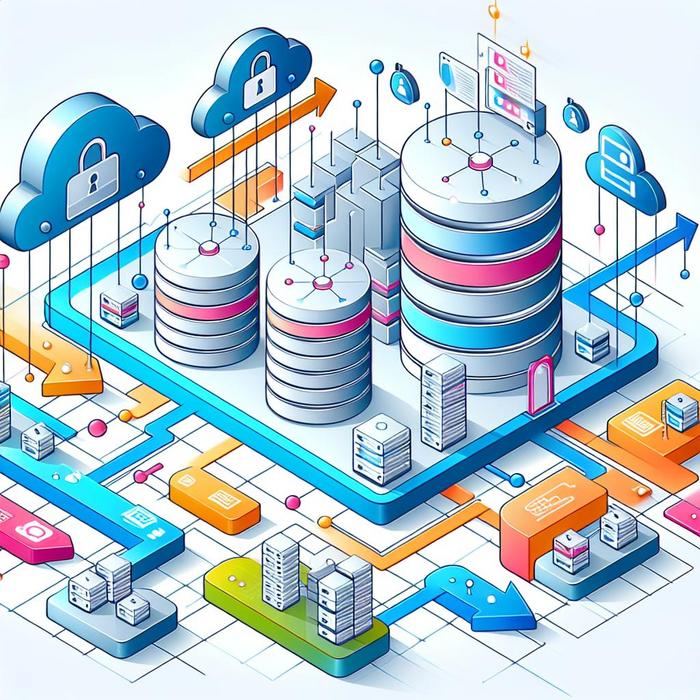Table of Contents Hide
Building Effective Data Governance Frameworks
 6 MIN. READING
6 MIN. READING
Unlocking Strategies for a Robust Data Governance Framework
Why is a Robust Framework Crucial in the Age of Data?
How do high-level executives navigate the labyrinth of data management to achieve strategic objectives? The answer lies in effective data governance frameworks. When built strategically, these models provide a solid platform for achieving data excellence, hitting the sweet spot between data accessibility, integrity, and security.
Mapping the Integral Elements of a Data Governance Framework
In enhancing your digital architecture, the components of a data governance framework assume a pivotal role. Let’s explore these core elements:
– Data Catalogue: A structured inventory of available data sets that enables efficient data provisioning for testing, development, and analytics.
Learn more about the benefits of using a data catalogue here.
– Database Virtualization: This involves the creation of a virtual data layer, providing unified access to information across disparate sources without the need for moving or duplicating the data.
– Data Anonymization: A clever approach to protecting sensitive data, this method involves shielding the identity of the data producer by altering identifiable characteristics.
– Compliance with Regulatory Frameworks: Data measures must adhere to the relevant regulatory frameworks, ensuring adherence to data privacy laws and industry regulations.
Realizing the Potential of Database Virtualization
Given your strategic role in data infrastructure, what can you expect from Database Virtualization? It revolutionizes the way data is provisioned for testing, development, and analytics, pushing the boundaries of accessibility, and boosting operational efficiency.
Achieve agility in your data management practices with these strategies
Securing Data Through Anonymization
Implementing data anonymization goes beyond merely masking data; it’s about creating an iron-clad shield that protects sensitive information without compromising on data utility. This method ensures that even if data falls into wrong hands, it cannot be traced back to the original producer, thereby protecting privacy.
Striving for Compliance in the Data Landscape
How do you navigate the complex terrain of data laws and regulations while ensuring your data remains useful for business insights? Maintaining compliance with regulatory frameworks calls for a well-defined strategy. Aim to strike a balance between compliance requirements and your organization’s specific needs. Prioritizing compliance can also serve as an excellent starting point for data governance initiatives.
Adopting a Data Governance Framework – What’s the Next Step?
So, ready to build a solid data governance framework leveraging database virtualization, data anonymization, and regulatory compliance? Begin by understanding the importance of data governance and design a framework that suits your organizational needs.
For more insights on data governance frameworks, click here.
Stay ahead of the curve with a robust data governance framework that reflects your business’s strategic vision while meeting the needs of a constantly evolving data landscape. Remember, mastering data governance is a continuous process – one that demands ongoing commitment, comprehensive strategies, and innovative approaches.
The Dynamics of a Data Catalogue
A data catalogue is a paramount resource in your data management strategy. But why is it so essential? Having a well-structured data catalogue enables effective test data provisioning and utilization, facilitates a smooth workflow, and promotes an agile process that delivers actionable insights in the fast-changing digital environment. This powerful tool ensures that your data assets are easily discoverable, interpretable and accurately tagged, which subsequently drives business decisions and innovations.
Pioneering with Database Virtualization
Database virtualization is a transformative technique in making crucial information available at the tip of your fingers, regardless of the data source being diversified. This compelling technology allows the creation of a virtual, integrated layer of data without the need for duplicating or moving it, which is of paramount significance for development, testing, and analytics. It’s a paradigm shift that impacts how data is accessed and interpreted, dramatically reducing the time and resources required while guaranteeing data accuracy.
Discover the transformative potential of database virtualization here.
Diving Deep into Data Anonymization
The practice of data anonymization is an ingenious approach to secure sensitive data. By modifying identifiable elements, it shields the identity of the data producer. But its value extends beyond security. By implementing meticulous data anonymization methods, data becomes both safe and useful, preserving its integrity and utility. The critical point is that, in an unlikely event of a data breach, the data will stay secure as it cannot be traced back to its original source.
Importance of Regulatory Compliance in Data Governance
Regulatory compliance is a critical cornerstone of any data governance strategy. With stringent data laws and regulations, it is essential to strike a balance between adhering to these requirements and ensuring that your data remains productive for your business operations.
An understanding of the regulatory landscape and its impact on your organization’s data landscape advances your strategic decision-making. Furthermore, it helps you manage risks, demonstrate accountability and earn the trust of stakeholders. The regulatory compliance in your data management architecture is a testament to your commitment to responsible data governance.
Straight ahead with a dynamic Data Governance Framework
Armed with the understanding of a data governance framework’s components, it’s time to look forward, designing and implementing a robust model tailored to your organization. Prioritize elements like database virtualization, data anonymization, and regulatory compliance in your blueprint.
It’s essential to remember that data governance is not a run-of-the-mill process – it’s an evolving journey that requires an enduring commitment. It demands tactical strategies, a scalable structure, and an accommodating mindset to accommodate the evolving landscape of data management.
Click here to delve deeper into the world of data governance frameworks.
Evolving Landscape of Data Governance Frameworks
As we steer into an increasingly data-driven era, mastering data governance is becoming a critical survival skill for organizations. As advanced as the technology may be, the true value of data is realized not merely through access but through intelligent and ethical management.
Learn more about the evolving landscape of data governance models here.
Powering ahead
Entries in the ledger of data governance may fade, be erased or rewritten as the narrative of technological advancement unfolds. Adaptability is crucial; dynamism is necessary; innovation is crucial.
Seek expertise in creating a dynamic data governance framework here. Empowered with a meticulously designed data governance model, you can effortlessly align your strategic vision with the demands of today’s increasingly complex data ecosystem.
Remember, navigating the realm of data governance is no small feat – it requires continual commitment, comprehensive strategies, innovative thinking, ethical implementation, and technical empowerment. Embrace the transformative potential of database virtualization, the protection assured by data anonymization, and the legal integrity of regulatory compliance. Traverse fearlessly, knowing that every forward step fuels a more robust data governance framework.


